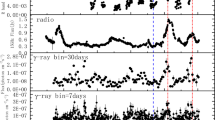Abstract
Various parameters describing the dynamics of G-band bright points (GBPs) were derived from G-band images, acquired by the Dutch Open Telescope (DOT), of a quiet region close to the disk center. Our study is based on four commonly used diagnostics (effective velocity, change in the effective velocity, change in the direction angle, and centrifugal acceleration) and two new ones (rate of motion and time lag between recurrence of GBPs). The results concerning the commonly used parameters are in agreement with previous studies for a comparable spatial and temporal resolution of the used data. The most probable value of the effective velocity is ∼ 0.9 km s−1, whereas we found a deviation of the effective velocity distribution from the expected Rayleigh function for velocities in the range from 2 to 4 km s−1. The change in the effective velocity distribution is consistent with a Gaussian one with FWHM=0.079 km s−2. The distribution of the centrifugal acceleration exhibits a highly exponential nature (a symmetric Gaussian centered at the zero value). To broaden our understanding of the dynamics of GBPs, two new parameters were defined: the real displacement between their appearance and disappearance (rate of motion) and the frequency of their recurrence at the same locations (time lag). For ∼ 45 % of the tracked GBPs, their displacement was found to be small compared to their size (the rate of motion smaller than one). The locations of the tracked GBPs mainly cover the boundaries of supergranules representing the network, and there is no significant difference in the locations of GBPs with small (m<1) and large (m>2) values of the rate of motion. We observed a difference in the overall trend of the obtained distribution for the values of the time lag smaller (slope of the trend line being −0.14) and greater (−0.03) than ∼ 7 min. The time lags mostly lie within the interval of ∼ 2 – 3 min, with those up to ∼ 4 min being more abundant than longer ones. Results for both new parameters indicate that the locations of different dynamical types of GBPs (stable/farther traveling or with short/long lifetimes) are bound to the locations of more stable and long-living magnetic field concentrations. Thus, the disappearance/reappearance of the tracked GBPs cannot be perceived as the disappearance/reappearance of their corresponding magnetic field concentrations.









Similar content being viewed by others
References
Abramenko, V., Yurchyshyn, V., Goode, P., Kilcik, A.: 2010, Statistical distribution of size and lifetime of bright points observed with the New Solar Telescope. Astrophys. J. Lett. 725, L101 – L105. doi: 10.1088/2041-8205/725/1/L101 .
Beck, C., Bellot Rubio, L.R., Schlichenmaier, R., Sütterlin, P.: 2007, Magnetic properties of G-band bright points in a sunspot moat. Astron. Astrophys. 472, 607 – 622. doi: 10.1051/0004-6361:20065620 .
Berger, T.E., Title, A.M.: 1996, On the dynamics of small-scale solar magnetic elements. Astrophys. J. 463, 365 – 371. doi: 10.1086/177250 .
Berger, T.E., Title, A.M.: 2001, On the relation of G-band bright points to the photospheric magnetic field. Astrophys. J. 553, 449 – 469. doi: 10.1086/320663 .
Berger, T.E., Schrijver, C.J., Shine, R.A., Tarbell, T.D., Title, A.M., Scharmer, G.: 1995, New observations of subarcsecond photospheric bright points. Astrophys. J. 454, 531 – 544. doi: 10.1086/176504 .
Berger, T.E., Loefdahl, M.G., Shine, R.S., Title, A.M.: 1998, Measurements of solar magnetic element motion from high-resolution filtergrams. Astrophys. J. 495, 973 – 983. doi: 10.1086/305309 .
Bodnárová, M., Utz, D., Rybák, J., Hanslmeier, A.: 2010, Dynamics of G-band bright points derived using two fully automated algorithms. Cent. Eur. Astrophys. Bull. 34, 25 – 30.
Bovelet, B., Wiehr, E.: 2007, Multiple-scale pattern recognition applied to faint intergranular G-band structures. Solar Phys. 243, 121 – 129. doi: 10.1007/s11207-007-9010-x .
Carlsson, M., Stein, R.F., Nordlund, Å., Scharmer, G.B.: 2004, Observational manifestations of solar magnetoconvection: center-to-limb variation. Astrophys. J. Lett. 610, L137 – L140. doi: 10.1086/423305 .
Choudhuri, A.R., Auffret, H., Priest, E.R.: 1993, Implications of rapid footpoint motions of photospheric flux tubes for coronal heating. Solar Phys. 143, 49 – 68. doi: 10.1007/BF00619096 .
Danilovic, S., Schüssler, M., Solanki, S.K.: 2010, Magnetic field intensification: comparison of 3D MHD simulations with Hinode/SP results. Astron. Astrophys. 509, A76. doi: 10.1051/0004-6361/200912283 .
de Wijn, A.G., Rutten, R.J., Haverkamp, E.M.W.P., Sütterlin, P.: 2005, DOT tomography of the solar atmosphere. IV. Magnetic patches in internetwork areas. Astron. Astrophys. 441, 1183 – 1190. doi: 10.1051/0004-6361:20053373 .
de Wijn, A.G., Lites, B.W., Berger, T.E., Frank, Z.A., Tarbell, T.D., Ishikawa, R.: 2008, Hinode observations of magnetic elements in internetwork areas. Astrophys. J. 684, 1469 – 1476. doi: 10.1086/590237 .
Möstl, C., Hanslmeier, A., Sobotka, M., Puschmann, K., Muthsam, H.J.: 2006, Dynamics of magnetic bright points in an active region. Solar Phys. 237, 13 – 23. doi: 10.1007/s11207-006-0131-4 .
Muller, R., Roudier, T.: 1984, Variability of the quiet photospheric network. Solar Phys. 94, 33 – 47. doi: 10.1007/BF00154805 .
Muller, R., Roudier, T., Vigneau, J., Auffret, H.: 1994, The proper motion of network bright points and the heating of the solar corona. Astron. Astrophys. 283, 232 – 240.
Nisenson, P., van Ballegooijen, A.A., de Wijn, A.G., Sütterlin, P.: 2003, Motions of isolated G-band bright points in the solar photosphere. Astrophys. J. 587, 458 – 463. doi: 10.1086/368067 .
Parker, E.N.: 1988, Nanoflares and the solar X-ray corona. Astrophys. J. 330, 474 – 479. doi: 10.1086/166485 .
Romano, P., Berrilli, F., Criscuoli, S., Del Moro, D., Ermolli, I., Giorgi, F., Viticchié, B., Zuccarello, F.: 2012, A comparative analysis of photospheric bright points in an active region and in the quiet Sun. Solar Phys. 280, 407 – 416. doi: 10.1007/s11207-012-9942-7 .
Rutten, R.J., Hammerschlag, R.H., Bettonvil, F.C.M., Sütterlin, P., de Wijn, A.G.: 2004, DOT tomography of the solar atmosphere. I. Telescope summary and program definition. Astron. Astrophys. 413, 1183 – 1189. doi: 10.1051/0004-6361:20031548 .
Sánchez Almeida, J., Márquez, I., Bonet, J.A., Domínguez Cerdeña, I., Muller, R.: 2004, Bright points in the internetwork quiet Sun. Astrophys. J. Lett. 609, L91 – L94. doi: 10.1086/422752 .
Shelyag, S., Schüssler, M., Solanki, S.K., Vögler, A.: 2007, Stokes diagnostics of simulated solar magneto-convection. Astron. Astrophys. 469, 731 – 747. doi: 10.1051/0004-6361:20066819 .
Steiner, O.: 2005, Radiative properties of magnetic elements. II. Center to limb variation of the appearance of photospheric faculae. Astron. Astrophys. 430, 691 – 700. doi: 10.1051/0004-6361:20041286 .
Sütterlin, P., Hammerschlag, R.H., Bettonvil, F.C.M., Rutten, R.J., Skomorovsky, V.I., Domyshev, G.N.: 2001, A multi-channel speckle imaging system for the DOT. In: Sigwarth, M. (ed.) Advanced Solar Polarimetry – Theory, Observation, and Instrumentation, Astronomical Society of the Pacific Conference Series 236, 431 – 438.
Title, A.M., Tarbell, T.D., Topka, K.P.: 1987, On the relation between magnetic field structures and granulation. Astrophys. J. 317, 892 – 899. doi: 10.1086/165339 .
Utz, D., Hanslmeier, A., Möstl, C., Muller, R., Veronig, A., Muthsam, H.: 2009, The size distribution of magnetic bright points derived from Hinode/SOT observations. Astron. Astrophys. 498, 289 – 293. doi: 10.1051/0004-6361/200810867 .
Utz, D., Hanslmeier, A., Muller, R., Veronig, A., Rybák, J., Muthsam, H.: 2010, Dynamics of isolated magnetic bright points derived from Hinode/SOT G-band observations. Astron. Astrophys. 511, A39. doi: 10.1051/0004-6361/200913085 .
Utz, D., Hanslmeier, A., Muller, R., Veronig, A., Rybák, J., Muthsam, H.: 2012, Dependence of velocity distributions of small-scale magnetic fields derived from Hinode/SOT G-band filtergrams on the temporal resolution of the used data sets. In: Sekii, T., Watanabe, T., Sakurai, T. (eds.) Hinode-3: The 3rd Hinode Science Meeting, Astronomical Society of the Pacific Conference Series 454, 55 – 58.
Utz, D., Jurčák, J., Hanslmeier, A., Muller, R., Veronig, A., Kühner, O.: 2013, Magnetic field strength distribution of magnetic bright points inferred from filtergrams and spectro-polarimetric data. Astron. Astrophys. 554, A65. doi: 10.1051/0004-6361/201116894 .
Viticchié, B., Del Moro, D., Criscuoli, S., Berrilli, F.: 2010, Imaging spectropolarimetry with IBIS. II. On the fine structure of G-band bright features. Astrophys. J. 723, 787 – 796. doi: 10.1088/0004-637X/723/1/787 .
Acknowledgements
The Technology Foundation STW in the Netherlands financially supported the development and construction of the DOT and follow-up technical developments. The DOT has been built by instrumentation groups of Utrecht University and Delft University (DEMO) and several firms with specialized tasks. The DOT is located at Observatorio del Roque de los Muchachos (ORM) of Instituto de Astrofísica de Canarias (IAC). DOT observations on 19 October 2005 have been funded by the OPTICON Trans-national Access Programme and by the ESMN-European Solar Magnetic Network – both programs of the EU FP6. The authors thank P. Sütterlin for the DOT observations and R. Rutten for the data reduction. This work was supported by the Slovak Research and Development Agency under the contract No. APVV-0816-11. We acknowledge support by the project VEGA 2/0108/12. We are indebted to an anonymous reviewer whose comments improved the paper substantially.
Author information
Authors and Affiliations
Corresponding author
Rights and permissions
About this article
Cite this article
Bodnárová, M., Utz, D. & Rybák, J. On Dynamics of G-Band Bright Points. Sol Phys 289, 1543–1556 (2014). https://doi.org/10.1007/s11207-013-0428-z
Received:
Accepted:
Published:
Issue Date:
DOI: https://doi.org/10.1007/s11207-013-0428-z




